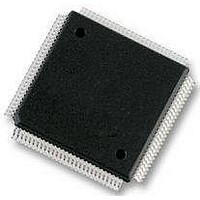MC912D60CCPVE Freescale Semiconductor, MC912D60CCPVE Datasheet - Page 145

MC912D60CCPVE
Manufacturer Part Number
MC912D60CCPVE
Description
IC MCU 16BIT 112-LQFP
Manufacturer
Freescale Semiconductor
Series
HC12r
Datasheet
1.MC912D60ACFUE8.pdf
(460 pages)
Specifications of MC912D60CCPVE
Core Processor
CPU12
Core Size
16-Bit
Speed
8MHz
Connectivity
CAN, MI Bus, SCI, SPI
Peripherals
POR, PWM, WDT
Number Of I /o
68
Program Memory Size
60KB (60K x 8)
Program Memory Type
FLASH
Eeprom Size
1K x 8
Ram Size
2K x 8
Voltage - Supply (vcc/vdd)
4.5 V ~ 5.5 V
Data Converters
A/D 16x8/10b
Oscillator Type
Internal
Operating Temperature
-40°C ~ 85°C
Package / Case
112-LQFP
Processor Series
HC912D
Core
HC12
Data Bus Width
16 bit
Data Ram Size
2 KB
Interface Type
CAN, SCI, SPI
Maximum Clock Frequency
8 MHz
Number Of Programmable I/os
86
Maximum Operating Temperature
+ 85 C
Mounting Style
SMD/SMT
3rd Party Development Tools
EWHCS12
Minimum Operating Temperature
- 40 C
On-chip Adc
10 bit, 8 Channel
Lead Free Status / RoHS Status
Lead free / RoHS Compliant
Available stocks
Company
Part Number
Manufacturer
Quantity
Price
Company:
Part Number:
MC912D60CCPVE
Manufacturer:
FREESCAL
Quantity:
203
Company:
Part Number:
MC912D60CCPVE
Manufacturer:
Freescale Semiconductor
Quantity:
10 000
- Current page: 145 of 460
- Download datasheet (5Mb)
11.6.2 No Clock at Power-On Reset
MC68HC912D60A — Rev. 3.1
Freescale Semiconductor
CAUTION:
NOTE:
values before the clock loss. All clocks return to their normal settings and
Clock Monitor control is returned to the CME & FCME bits. If AUTO and
BCSP bits were set before the clock loss (selecting the PLL to provide a
system clock) the SYSCLK ramps-up and the PLL locks at the previously
selected frequency. To prevent PLL operation when the external clock
frequency comes back, software should clear the BCSP bit while running
in limp-home mode.
The two shaded regions A and B in
away due to incorrect clocks on SYSCLK if the MCU is clocked by
EXTALi and the PLL is not used.
In region A, there is a delay between the loss of clock and its detection
by the clock monitor. When the EXTALi clock signal is disturbed, the
clock generation circuitry may receive an out of spec signal and drive the
CPU with irregular clocks. This may lead to code runaway.
In region B, as the 13-stage counter is free running, the count of 4096
may be reached when the amplitude of the EXTALi clock has not
stabilized. In this case, an improper EXTALi is sent to the clock
generation circuitry when limp-home mode is exited. This may also
cause code runaway.
If the MCU is clocked by the PLL, the risk of code runaway is very
low, but it can still occur under certain conditions due to irregular
clocks from the clock source appearing on the SYSCLK.
The COP watch dog should always be enabled in order to reset the MCU
in case of a code runaway situation.
It is always advisable to take additional precautions within the
application software to trap such situations.
The voltage level on VDDPLL determines how the MCU responds to an
external clock loss in this case.
With the VDDPLL supply voltage at VDD level, any reset sets the Clock
Monitor Enable bit (CME) and the PLLON bit and clears the NOLHM bit.
Clock Functions
Limp-Home and Fast STOP Recovery modes
Figure 11-3
present a of code run
Clock Functions
Technical Data
145
Related parts for MC912D60CCPVE
Image
Part Number
Description
Manufacturer
Datasheet
Request
R
Part Number:
Description:
Manufacturer:
Freescale Semiconductor, Inc
Datasheet:
Part Number:
Description:
Manufacturer:
Freescale Semiconductor, Inc
Datasheet:
Part Number:
Description:
Manufacturer:
Freescale Semiconductor, Inc
Datasheet:
Part Number:
Description:
Manufacturer:
Freescale Semiconductor, Inc
Datasheet:
Part Number:
Description:
Manufacturer:
Freescale Semiconductor, Inc
Datasheet:
Part Number:
Description:
Manufacturer:
Freescale Semiconductor, Inc
Datasheet:
Part Number:
Description:
Manufacturer:
Freescale Semiconductor, Inc
Datasheet:
Part Number:
Description:
Manufacturer:
Freescale Semiconductor, Inc
Datasheet:
Part Number:
Description:
Manufacturer:
Freescale Semiconductor, Inc
Datasheet:
Part Number:
Description:
Manufacturer:
Freescale Semiconductor, Inc
Datasheet:
Part Number:
Description:
Manufacturer:
Freescale Semiconductor, Inc
Datasheet:
Part Number:
Description:
Manufacturer:
Freescale Semiconductor, Inc
Datasheet:
Part Number:
Description:
Manufacturer:
Freescale Semiconductor, Inc
Datasheet:
Part Number:
Description:
Manufacturer:
Freescale Semiconductor, Inc
Datasheet:
Part Number:
Description:
Manufacturer:
Freescale Semiconductor, Inc
Datasheet:











